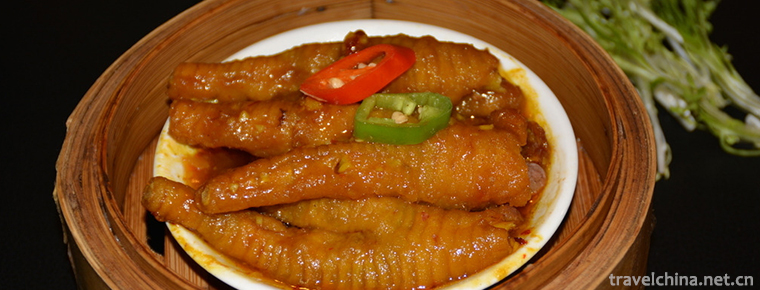Steamed chicken feet with oyster sauce
Oyster Emperor steamed chicken feet, a featured delicacy, the main raw materials are chicken feet, small red pepper, oyster oil and so on, suitable for all ages.
1. chicken feet wash away blood water and scissors cut out toenails.
2. put oil in the pan (larger, no chicken feet). After the oil is heated, add chicken feet and fry until golden.
3. remove the fried chicken feet and rinse the oil with water.
4. chicken feet soaked in water for 2 hours or so.
5. chopped the soaked chicken feet into small pieces (easy to taste).
6. chop the chicken feet, and pour a spoonful of oyster sauce.
7. knead the oyster sauce well with your hands, so that each chicken claw is evenly wrapped in oyster sauce.
8. small red chili washed and cut into small segments.
9. sprinkle small red peppers on chicken feet wrapped in oyster sauce.
10. chicken feet into a steamer and steam for 20 minutes.
11. after steaming, take the steamed chicken claw and add a tablespoon of oyster sauce to make the sticky juice.
12. before eating, pour the sauce on the chicken feet.


-
1.Altai mountains
The Altai mountains are located in the northern part of the Xinjiang Uygur Autonomous Region and the western part of Mongolia. Northwest extends to Russia
Time 2018-11-01 -
2.Quyuan Hometown Tourist Area
The cultural tourist area of Quyuan's hometown is located in Fenghuangshan, Zigui County, Yichang City, with a total area of 33.3 hectares in the north, Gaoxia Pinghu Lake in the north
Time 2018-12-12 -
3.Bezeklik Thousand Buddha Caves
The Qianfo Cave in Bozikrik is located on the cliff on the West Bank of the Wood Trench, 45 kilometers east of Turpan City, Xinjiang. There are 83 caves and 57 caves
Time 2019-01-02 -
4.Drum Mountain
Gushan is located in the east of Jin'an District, Fuzhou City, Fujian Province, and on the North Bank of Minjiang River. It is about 8 kilometers away from the downtown area. It is one of the most fam
Time 2019-01-12 -
5.Sea cucumber with eight treasures
Babao sea cucumber is a traditional dish in Yichang City, Hubei Province. "Babao" means ham, hoof tendons, chicken, winter bamboo shoots, shrimp, mushrooms, lotus seeds and water chestnut; i
Time 2019-03-25 -
6.Drum Dance
Dance and drum dance is a kind of folk dance of Miao nationality in China. Miao people's "encouragement" has a long history. The written records of Miao people's drumming
Time 2019-05-01 -
7.Grass grass drums and drums
Grass gongs and drums, also known as grass chants, are commonly known as "hilarious songs". It is a unique form of folk song art. It is a kind of Tujia folk song that the
Time 2019-05-02 -
8.Stone carving
Stone carving is a traditional Chinese folk micro-sculpture process. The peach stone, apricot stone, olive stone and walnut are carved into handicraft products, which have been listed in the second ba
Time 2019-05-03 -
9.Huang Di memorial ceremony
Yellow Emperor's sacrificial ceremony is a kind of sacrificial music and dance to celebrate Xuanyuan Huangdi's pioneering achievements in Chinese civilization. The theme of
Time 2019-05-04 -
10.Lv Opera
Lv Opera, also known as masqueraded Yangqin and Qinxi Opera, National intangible cultural heritage, one of the eight major Chinese operas, Shandong's most representative local operas, is popular in mo
Time 2019-05-15 -
11.Beijing Institute Of Petrochemical Technology
Beijing Petrochemical College was founded in 1978. It was developed from the Second Branch of Beijing Chemical College and Beijing Petrochemical College. It became more famous in 1992 and was transfer
Time 2019-09-06 -
12.West Anhui University
West Anhui University (West Anhui University) was the 3 menstrual period of 2000. Ministry of Education Approved provincial comprehensive Undergraduate Colleges From the original West Anhui United Uni
Time 2019-11-20